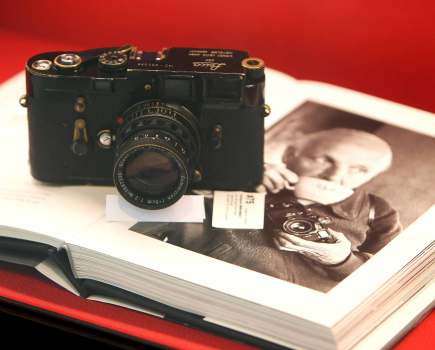Despite strict reporting restrictions imposed by the US Government, David Turnley?s Photograph became the iconic image from the 1991 Gulf War. David Clark tells its story
 ©David Turnley/Corbis
©David Turnley/Corbis
The ?best? war photographs ? those that achieve iconic status ? both sum up a particular conflict and comment on war in general in a single emotionally powerful image. Photographs such as Robert Capa?s ?Loyalist Militiaman at the Moment of Death? (1936), Don McCullin?s ?Shell-Shocked Soldier? (1968) and Nick Út?s ?Napalm Attack? (1972) have all given dramatic insights into front-line combat. Images like these have often helped turn public opinion decisively against particular wars.
Don McCullin, writing about war photography in The Guardian in 1993, said, ?It is the photographer?s job to show some of [the horror of war], to say: this is the real war, this is what it?s like on the ground, this is what war does to you. That job has been becoming increasingly difficult ever since the US decided that the media had lost the war in Vietnam for them.? Since that war ended, governments have increasingly restricted photographers? access to war zones and reserved the right to censor the results.
The 1991 Gulf War created a new benchmark in reporting restrictions, and the images photographers were allowed to publish were strictly controlled. At the time of the war, David Turnley was an acclaimed photojournalist. In 1988 he had won the top prize at the World Press Photo competition for his photograph of a man mourning his son, killed in the 1988 Armenian earthquake. Two years later he won a Pulitzer Prize for his photography covering the political uprisings in China and Eastern Europe.
When the Gulf War began, Turnley was one of a pool of photographers attached to the US Air Force. However, he found that his work was being restricted. ?We were accompanied by a public affairs officer whose job was to make sure we stuck to Pentagon restrictions,? he recalled in a BBC interview in 2005. ?This meant we would not be allowed to photograph casualties of war and certainly not war dead.
?While out in the field I got wind that much of the TV coverage was portraying a kind of sanitised war, one in which big technology was being used but that no human life, and particularly not American life, was at risk. It became clear to me that it was going to be very difficult for me to document the reality of the war.? Later, Turnley joined an elite MASH (mobile army surgical hospital) unit, which, by chance, didn?t have a public affairs officer attached to it.
After the fierce bombing raids of Operation Desert Storm and the later Allied invasion of Iraq on 24 February 1991, the brief but devastating war was coming to an end. During one of the final battles, Turnley was on board a military helicopter when it picked up the three-man crew of a Bradley Fighting Vehicle. It had taken a direct hit in a missile attack that was later revealed as ?friendly fire?. The vehicle?s driver, Andy Alaniz, was killed instantly and had been carried into the helicopter in a body bag; the two surviving men, who included Sergeant Ken Kozakiewicz, were both wounded and disorientated.
Turnley watched as a medical staff member handed Alaniz?s identity tag to the Sergeant. He photographed the moment that Kozakiewicz, seen in the picture on the left of the frame on page 28, realised that his friend and comrade was dead and began to cry. This image captures the tragedy of the soldier?s death on what turned out to be the last day of fighting.
?I knew this was going to be a good picture and I wanted to get it back to my editors in Saudi Arabia quickly,? Turnley later remembered. ?My only option was to send the film through the military.When I got to Saudi Arabia, I found out that my editors hadn?t received the film.?
When he questioned the US military officials about the film, he was told that it was being held until the next of kin were informed, although this had already happened. Turnley recalled that he went to the Lieutenant in charge and said, ?You know what happens in war and you are depriving these men of their due heroism ? the fact that they had to risk their lives to fight in this war.? The film was subsequently given back to Turnley and this one image was published in newspapers and magazines worldwide.
The photograph later won the Picture of the Year prize at the World Press Photo awards and confirmed Turnley?s reputation as one of the best contemporary photojournalists. He believes it has provoked such a strong reaction, and for many people has become symbolic of the war itself, because of its raw emotional power. ?It is an unbelievably intimate photo,? he has said. ?It reveals the vulnerability of otherwise strong men.
?It is not necessarily a photograph about American soldiers ? it?s about war and the young men who go to war. There is a certain nobility and dignity on the faces of these soldiers. I think that Ken Kozakiewicz touches chords that are deeply emotional in terms of his grief and his heroism. There is a certain everyman quality that becomes a very strong icon for the reality of war, which is always a tragic reality.? Ap
Recommended Resources
Books
David Turnley?s books include In Times of War and Peace, a collection of his (and his twin brother Peter?s) photojournalism, first published in 1997. More recently he has published two solo projects, Baghdad Blues: A War Diary (2003) and Mandela: Struggle and Triumph (2008).
Websites
David Turnley?s own website, www.davidcturnley.com. The BBC interview from which Turnley?s quotes in this feature were drawn can be found at https://news.bbc.co.uk/1/hi/4290906.stm.





